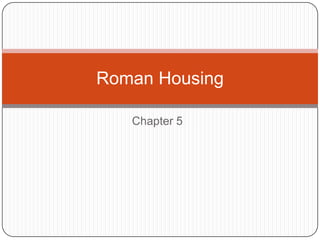
Roman Housing Types
- 1. Chapter 5 Roman Housing
- 2. Types of housing The Romans, like any civilization, had a variety of dwellings that varied in quality depending on the wealth of the person living there. Sprawling estates Town houses Apartments
- 3. Villa The most wealthy could have “second” homes on farms. The villa could range from a sprawling estate with many buildings and vast fields to a modest house with a garden. It was a place to go and relax, but could also be rented out for an income.
- 4. Domus A domus was a single-family dwelling along the city street. The rooms are centralized around a main hall or set of rooms (like the living room and kitchen). These homes came directly up to the sidewalk with no yard, but rather a garden contained within the walls of the home at the rear of the house. Pic source: http://www.woodlands-junior.kent.sch.uk/Homework/houses/Roman/townhouses.htm
- 5. Insulae The masses of Rome need to live in multi-family dwellings, or apartment buildings. These could be arranged around a central courtyard that would let in light or have a water source. Most residents would need to utilize the food shops (restaurants) and public latrines (toilets). Source: http://archipaedia.net/2009/05/style-history-ancient-roman/
- 6. Insulae (con’t) Insulae were not well constructed. At one point they were so prone to collapse or fire, that they were limited to 3 stories and fire regulations had to be created. For the Romans, the best apartments were the ones on the ground floor or the first floor with dwellings. (Sometimes, the first floor would be rented out as shops.) The worst and least expensive apartments were the ones at the top, since there were more stairs to climb and the most dangerous.
- 7. Common Rooms There were some rooms that were standard in the Roman house. Atrium: living room and a reception room in which visitors were received. (see pic) Tablinum: a home office. Peristylium: colonnaded courtyard. Triclinium: the dining room. The Romans often entertained with dinner parties, so this was a key room in the house. Pic Source: http://www.nga.gov/exhibitions/2008/pompeii/villa_houses.shtm
- 9. Atrium The atrium was the reception room. It contained a small hole in the roof (compluvium) which directed rainwater to the shallow basin (impluvium) below. The compluvium also provided much needed light. Pic source: http://etc.usf.edu/clipart/mysearch.php?searchWords=roman+impluvium&mySubmit=Search
- 10. Tablinum The tablinum was the study. The paterfamilias would meet clientes in this room. Pic source: http://www.indiana.edu/~c494troy/papyri/getty_marble_tablinum.jpg
- 11. Peristylium The peristylium was the colonnaded garden within the walls of the house. Pic source: http://www.nga.gov/exhibitions/2008/pompeii/courtyard.shtm
- 12. Triclinium The triclinium was the Roman dining room. Three diners would recline on each of three sides. One side was left open in order for the slaves to bring in the food. Pic source: http://www.vanalstyneisd.org/Latinpg/triclinium.html
- 13. Exterior Design Windows were placed high up to discourage thieves, as glass was reserved only for the wealthiest people. In all, the outside of a Roman house was unattactive and uninviting.
- 14. Interior Decoration Frescoes were painted while the plaster was still wet. Subjects for the paintings often included scenes from the country or mythology. Pic source: http://www.historywiz.com/galleries/anc-romegallery.htm ◀ Back
- 15. Interior Decoration (con’t) The Romans also used mosaics to decorate their floors. The mosaics could range from simple black and white geometrical designs to more elaborate scenes from mythology. Pic source: http://commons.wikimedia.org/wiki/File:Roman_mosaic_floor_LosAngeles_County_Museum_California.jpg